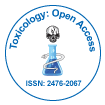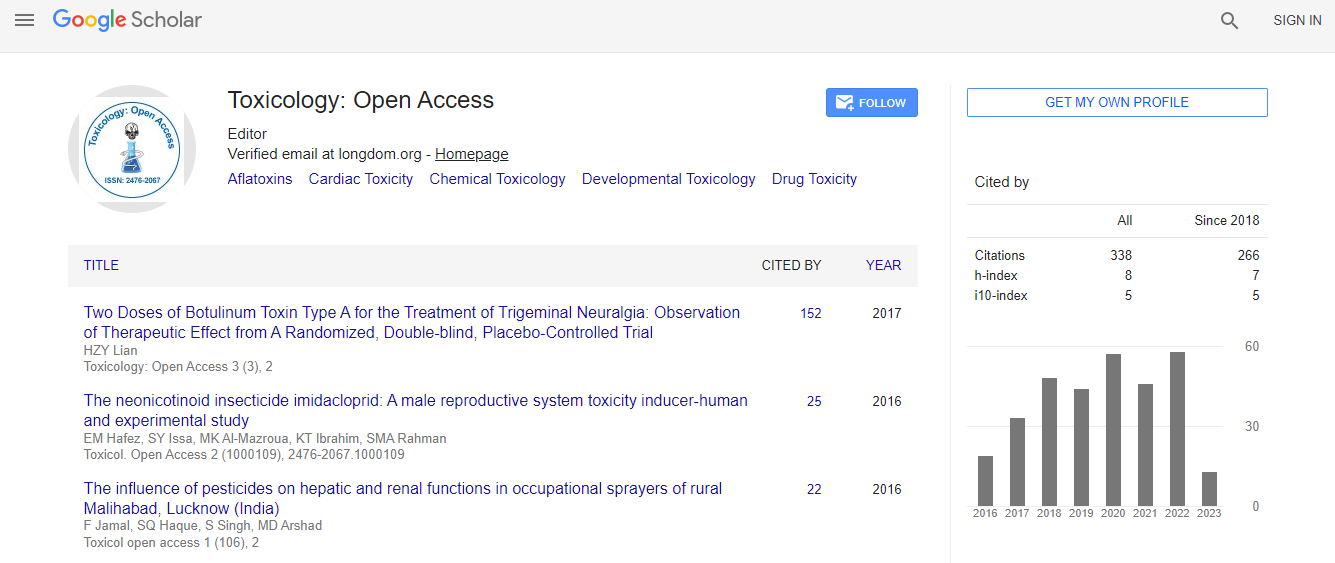Our Group organises 3000+ Global Conferenceseries Events every year across USA, Europe & Asia with support from 1000 more scientific Societies and Publishes 700+ Open Access Journals which contains over 50000 eminent personalities, reputed scientists as editorial board members.
Open Access Journals gaining more Readers and Citations
700 Journals and 15,000,000 Readers Each Journal is getting 25,000+ Readers
Google Scholar citation report
Citations : 336
Toxicology: Open Access received 336 citations as per Google Scholar report
Indexed In
- Google Scholar
- RefSeek
- Hamdard University
- EBSCO A-Z
- Geneva Foundation for Medical Education and Research
- Euro Pub
- ICMJE
Useful Links
Related Subjects
Share This Page
Phytofabrication of silver nanomedicine: An approach to overcome hepatocellular ailments
8th World Congress on Toxicology and Pharmacology
Asha Singh, Sadhana Shrivastava and Sangeeta Shukla
Jiwaji University, India
Posters & Accepted Abstracts: Toxicol Open Access
Abstract
Statement of the Problem: Nanomedicine research is currently an area of adoring scientific curiosity due to its wide variety of potential application in therapeutic and biomedical interest. In the present study, Morus alba L. leaves were used as reducing agents to prepare a silver nanomedicine with an aim to enhance the preventive efficacy of bioactive compounds present in these leaves for the treatment of hepatic ailment in rats. Methodology & Theoretical Orientation: Hepatotoxicity in albino rats was induced by intraperitoneal injection of N-nitrosodiethylamine and was treated with different doses of silver nanomedicine to find nanodrug. After the experimental period, blood and liver samples were collected from dissected animals, for haematological and biochemical analysis. The levels of oxidative markers, antioxidant status and inflammatory markers were estimated in serum and tissue homogenates whereas histopathological observations were assessed in the tissue of control and experimental animals. Findings: The administration of NDEA showed significant rise in the above biochemical parameters, whereas the levels of enzymatic antioxidants were decreased. Obtained results demonstrated that the screening of biologically synthesised AgNPs at different doses reverse the elevated levels of these enzymes significantly towards normal. Additionally, both the higher doses markedly recoup the antioxidant status. Histopathological studies also showed recovery towards normal in same manner. AgNPs at a dose of 100 �¼g/kg was found to be most effective in comparison to both the lower doses of leaf extract. Conclusion & Significance: Above findings powerfully support that M. alba leaves have therapeutic potential and biologically synthesized AgNPs enhance its efficacy and can be used as nanomedicine against hepatocellular disorder.Biography
Asha Singh is a BSR-UGC fellowship awardee, pursuing PhD. She has completed her Master’s and Philosophy degrees in Life Sciences. She has published a scientific paper and a book, also was awarded in toxicology presentation organized by Society of Toxicology.
Email: ashasgh87@gmail.com

 Spanish
Spanish  Chinese
Chinese  Russian
Russian  German
German  French
French  Japanese
Japanese  Portuguese
Portuguese  Hindi
Hindi 